Research on Packet Control Strategy of Constant-Frequency Air-Conditioning Demand Response Based on Improved Particle Swarm Optimization Algorithm
Abstract
:1. Introduction
2. Model and Analysis of Constant-Frequency Air Conditioners
2.1. Physical Model of Constant-Frequency Air Conditioners
2.2. Modelling of the Air-Conditioning Load Clusters
2.3. Analysis of the Regulation Capability of Air-Conditioning Clusters
3. Power Consumption Model and Regulatory Capability Analysis of Constant-Frequency Air Conditioners
3.1. Group Methodology and State-Queueing Model
- Based on the analyses given in (2) and (3), the power consumption of the constant-frequency air conditioners is closely related to the parameters representing the temperature variable, RC, and the distinct temperature difference, QR, yielded from the aforementioned parameters Q, R, and C, generated by Monte Carlo simulations.
- Characterizing the constant-frequency air conditioners with the values of QR and RC, and aggregating them into different groups with K-means algorithms.
- Obtaining the characteristic values for each aggregated group; the total power consumption for each group is the accumulation of all the machines.
- Controlling the air-conditioning clusters of each group.
3.2. Control Strategy for the Air-Conditioning Load Based on the Improved PSO Algorithm
- Learning factors: this paper utilizes asynchronous learning factors, i.e., the two learning factors conduct different variations during the optimization process. This, as a result, enables the particle’s strong self-learning capability and weak self-learning capability at the initial stage of optimization, which also strengthens global searching capabilities. Additionally, this modification is beneficial for the convergence of the globally optimized solution. The expressions are updated as:
- 2.
- Inertia factor: a linearized inertia-weighted method is adopted in this paper, which linearly reduces the inertia weights from the maximum value to the minimum value. For the initial searching stage, enhancing the capability of global searching avoids the trap in the local solution. Moreover, for the later period, enhancing the capability of local searching assists in locking the optimized solution. The equation relating to the iteration is written as:
4. Case Studies
4.1. Simulation Scenarios
4.2. Analysis of the Simulation Results of the Air-Conditioning Aggregated Model
4.3. Analysis of the Simulation Results of the Demand Response Capability
4.4. Analysis of the Simulation Results of the Control Strategy
5. Conclusions
- Monte Carlo aggregation analysis is adopted based on the first-order ETP model. Combined with the users’ requests, such as users’ thermal comfort, the maximum theoretical capability for the load shedding of the air conditioners is up to 45%, which has significant demand response capability.
- The improved PSO algorithm-based control strategy for the aggregated air-conditioning load can accurately control the air-conditioning following the reference load. Additionally, it is superior to the traditional PSO algorithm in computation speed, convergence, precision, and load fluctuation, which can illuminate the practical application of the air-conditioning load accurately participating in the demand response.
Author Contributions
Funding
Data Availability Statement
Conflicts of Interest
References
- Yang, X.; Fu, G.; Liu, F.; Tian, Y.; Xu, Y.; Chai, Z. Potential evaluation and control strategy of air conditioning load aggregation response considering multiple factors. Power Syst. Technol. 2021, 46, 1–17. [Google Scholar]
- Muhammad, W.; Lin, Z.; Ding, Y.; Wen, F.; Liu, S.; Ivo, P. Technologies and Practical Implementations of Air-conditioner Based Demand Response. Mod. Power Syst. Clean Energy 2021, 9, 1395–1413. [Google Scholar]
- Cai, Z.; Wu, J.; Wang, R. Coordinated control research for voltage and reactive power of distribution network considering virtual energy storage of air-conditionings. Power Demand Side Manag. 2021, 23, 63–68. [Google Scholar]
- Hu, X.; Shao, L.; Gu, X.; Yu, M.; Chen, P.; Zhu, H.; Wang, Z. Hierarchical Control Architecture and Decentralized Cooperative Control Strategy for Large Scale Air Conditioning Load Participating in Peak Load Regulation. In Proceedings of the International Conference on Electricity Distribution, Tianjin, China, 30 December 2018; pp. 2925–2930. [Google Scholar]
- Zhang, T.; Jiang, X.; Zhang, H. Optimal dispatching of load aggregator considering refined potential evaluation. Power Demand Side Manag. 2022, 24, 15–21. [Google Scholar]
- Guan, G.; Xin, J. Grouping Control Method for Air Conditioning Load. Autom. Electr. Power Syst. 2016, 40, 40–46. [Google Scholar]
- Yang, D.; Lin, Z.; Lai, W.; Zhang, S.; Zhang, X. Load control strategy under the background of virtual power generation. Power Demand Side Manag. 2020, 22, 48–51. [Google Scholar]
- Wang, T.; Liu, X.; Wu, M.; Bao, Y.; Zhang, C.; Xu, Q.; Zhao, J. Research on load aggregation modeling and tracking control scheme for large scale air conditioning. Power Demand Side Manag. 2020, 22, 51–56. [Google Scholar]
- Zhao, J.; Zhao, B.; Gu, P.; Zhang, P. Coordinated control strategy of HVAC cluster based on interaction capability curve. Power Demand Side Manag. 2021, 23, 17–23. [Google Scholar]
- Nariman, M.; Julio, H.B.; Maria, M.S.; Samuel, R.W. Model Predictive Control of Distributed Air-Conditioning Loads to Compensate Fluctuations in Solar Power. IEEE Trans. Smart Grid 2017, 8, 3055–3065. [Google Scholar]
- Saxena, A.; De, M. Demand Response Management of Residential Loads with Integrated Temperature Dependent Appliances. In Proceedings of the 2018 Fifth International Conference on Emerging Applications of Information Technology (EAIT), Kolkata, India, 12–13 January 2018; pp. 1–4. [Google Scholar]
- Tindemans, S.H.; Strbac, G. Low-Complexity Decentralized Algorithm for Aggregate Load Control of Thermostatic Loads. IEEE Trans. Ind. Appl. 2021, 57, 987–998. [Google Scholar] [CrossRef]
- He, H.; Borhan, M.; Kameshwar, P.; Tyrone, L. Aggregate Flexibility of Thermostatically Controlled Loads. IEEE Trans. Power Syst. 2014, 30, 189–198. [Google Scholar]
- Shah, Z.A.; Sindi, H.F.; Ul-Haq, A.; Ali, M.A. Fuzzy Logic-Based Direct Load Control Scheme for Air Conditioning Load to Reduce Energy Consumption. IEEE Access 2020, 8, 117413–117427. [Google Scholar] [CrossRef]
- Zhou, L.; Zhu, M.; Zhang, Z.; Yin, Q.; Qian, X.J. Design of progressive time-differentiated peak pricing mechanism for aggregated air-conditioning load. Power Demand Side Manag. 2019, 21, 11–16. [Google Scholar]
- Bao, Y.; Chen, P.; Hu, M.; Zhu, X. Control parameter optimization of thermostatically controlled loads using a modified state-queuing model. J. Power Energy Syst. 2020, 6, 394–401. [Google Scholar] [CrossRef]
- Nariman, M.; Braslavsky, J.H. Modelling and Control of Ensembles of Variable-Speed Air Conditioning Loads for Demand Response. IEEE Trans. Smart Grid 2020, 11, 4249–4260. [Google Scholar]
- Naqvi, S.A.R.; Kar, K.; Bhattacharya, S.; Chandan, V. Peak Power Minimization for Commercial Thermostatically Controlled Loads in Multi-Unit Grid-Interactive Efficient Buildings. IEEE Trans. Sustain. Energy 2022, 13, 998–1010. [Google Scholar]
- Ferdyn-Grygierek, J.; Grygierek, K.; Gumińska, A.; Krawiec, P.; Oćwieja, A.; Poloczek, R.; Szkarłat, J.; Zawartka, A.; Zobczyńska, D.; Żukowska-Tejsen, D. Passive Cooling Solutions to Improve Thermal Comfort in Polish Dwellings. Energies 2021, 14, 3648. [Google Scholar] [CrossRef]
- Hei, S.; Jiang, S.; Yang, J.; Zhang, J. The Developing Process and Applicability Analysis of Fanger PMV Thermal Comfort Model. Low Temp. Archit. Technol. 2017, 39, 125–128. [Google Scholar]
- He, P. Study on Indoor Air Conditioning System Based on Comfort. Degree Thesis, Chongqing university, Chongqing, China, 2010. [Google Scholar]
- Zhou, L.; Li, Y.; Gao, C. Improvement of Temperature Adjusting Method for Aggregated Air-conditioning Loads and Its Control Strategy. Proc. CSEE 2014, 34, 5579–5589. [Google Scholar]
- Xun, G.; Eduardo, C.; Julian, L.; Cardenas, B.; Bo, C.; Saleh, A.; Chang, L. Robust Hierarchical Control Mechanism for Aggregated Thermostatically Controlled Loads. IEEE Trans. Smart Grid 2021, 12, 453–467. [Google Scholar]
- Saeid, B.; Fathy, H.K. Modeling and Control of Aggregate Air Conditioning Loads for Robust Renewable Power Management. IEEE Trans. Control Syst. Technol. 2013, 21, 1318–1327. [Google Scholar]

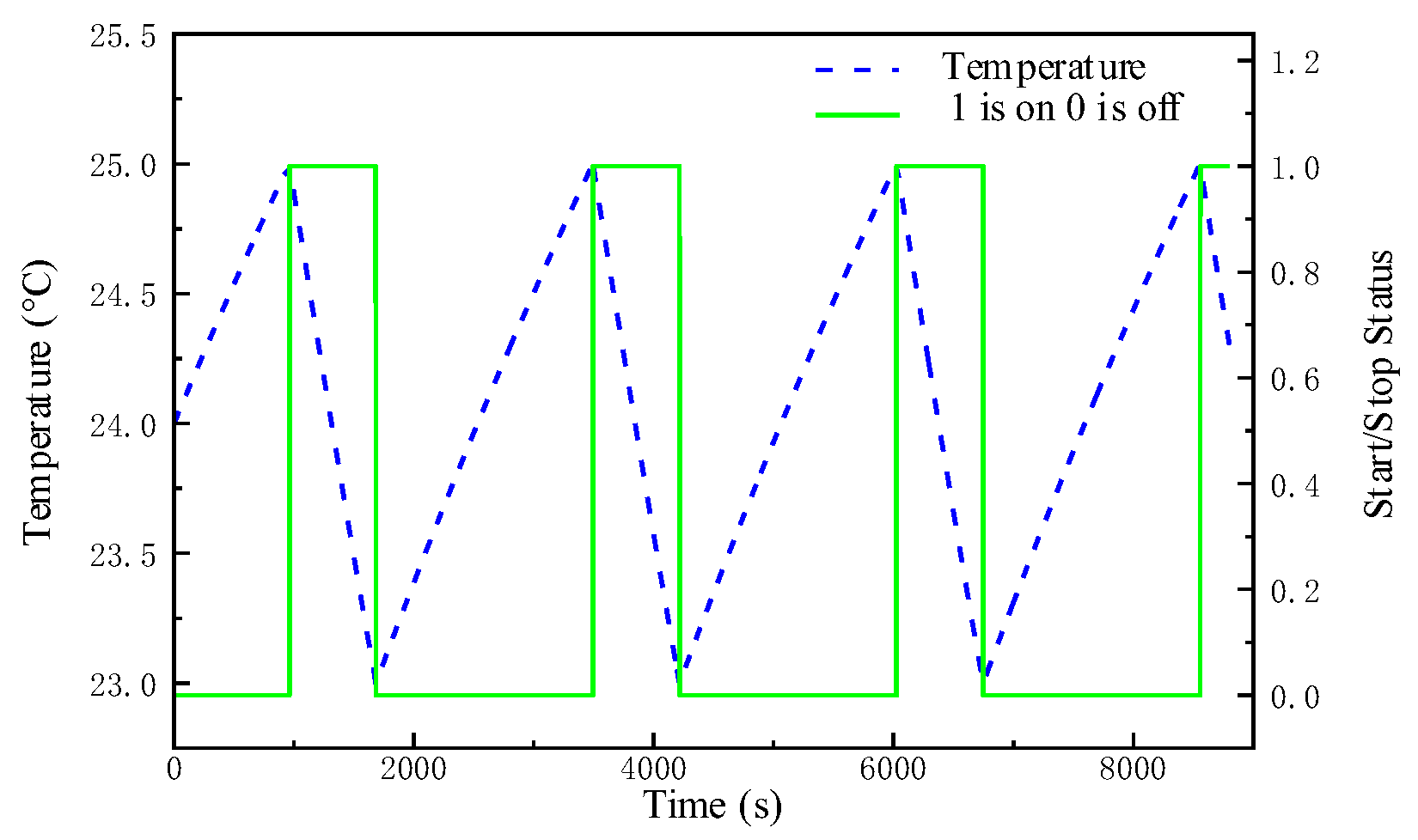
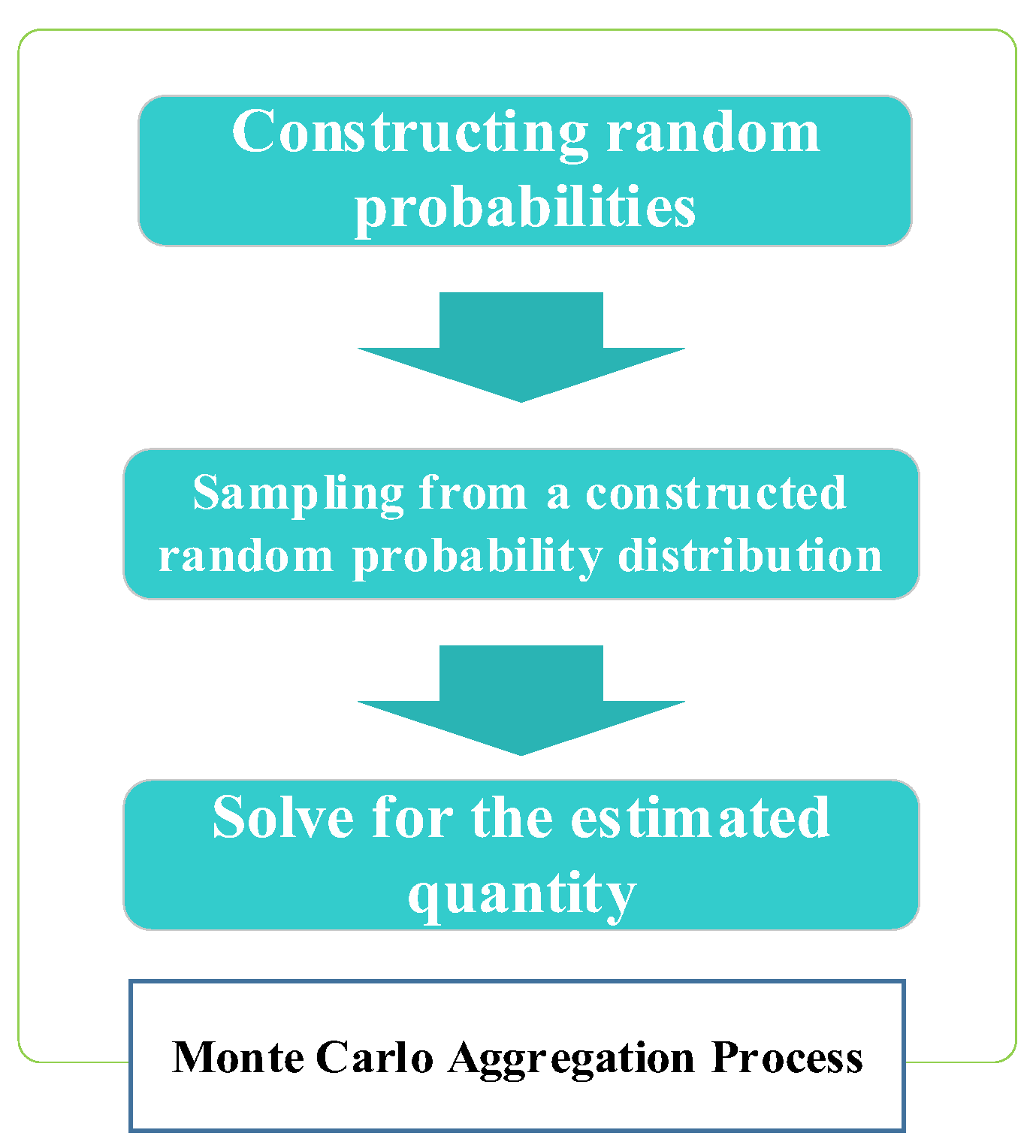
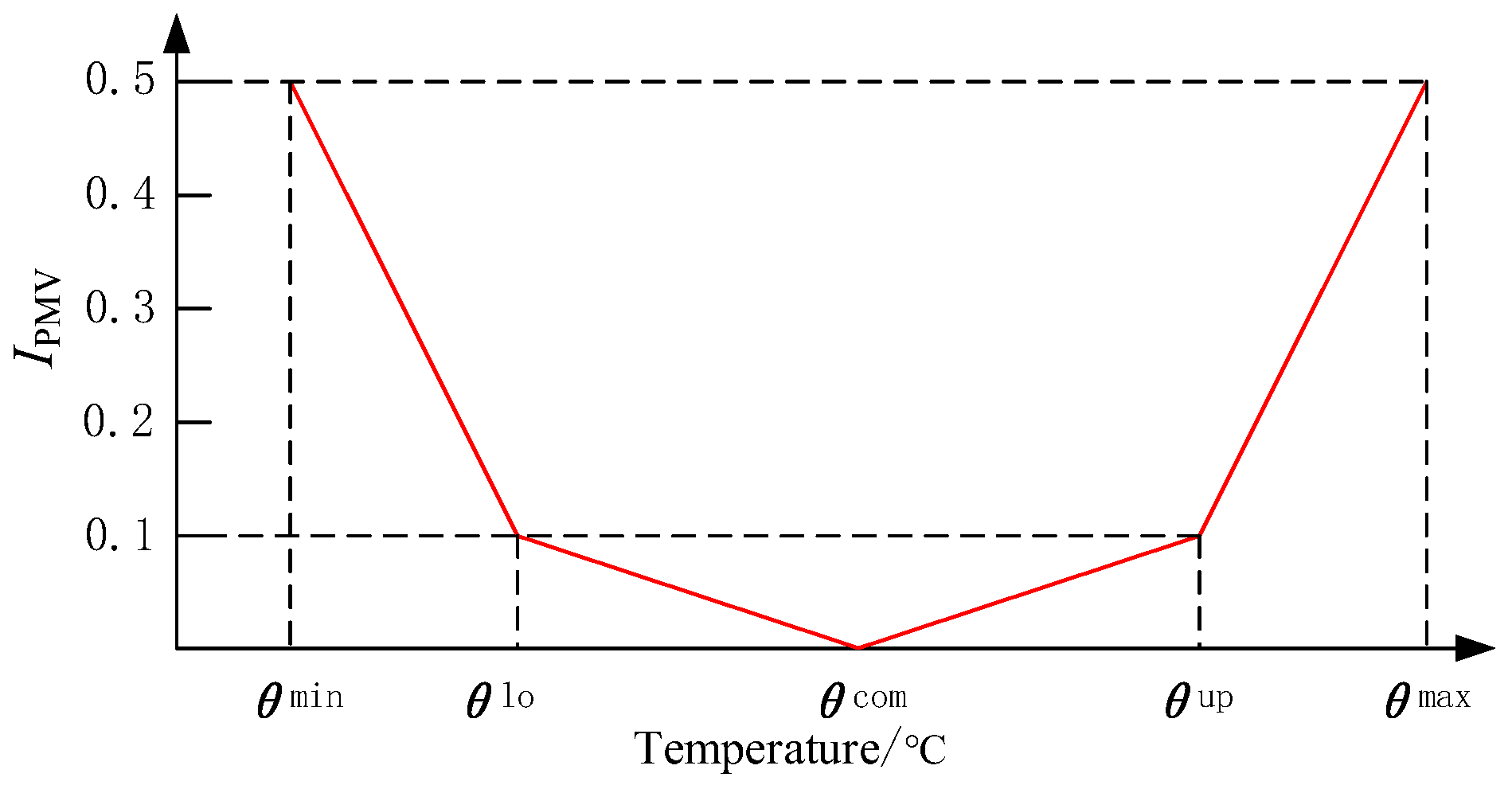
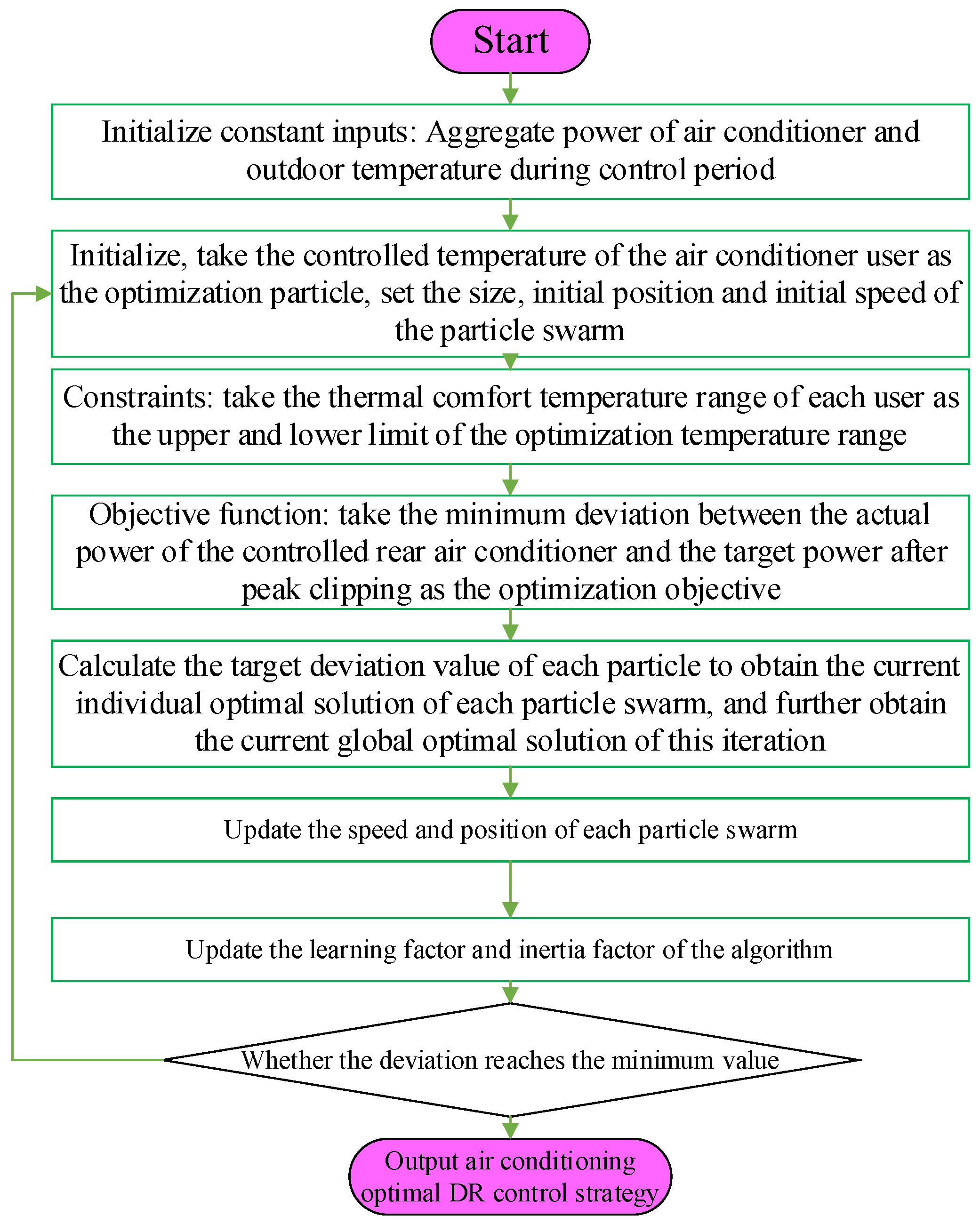


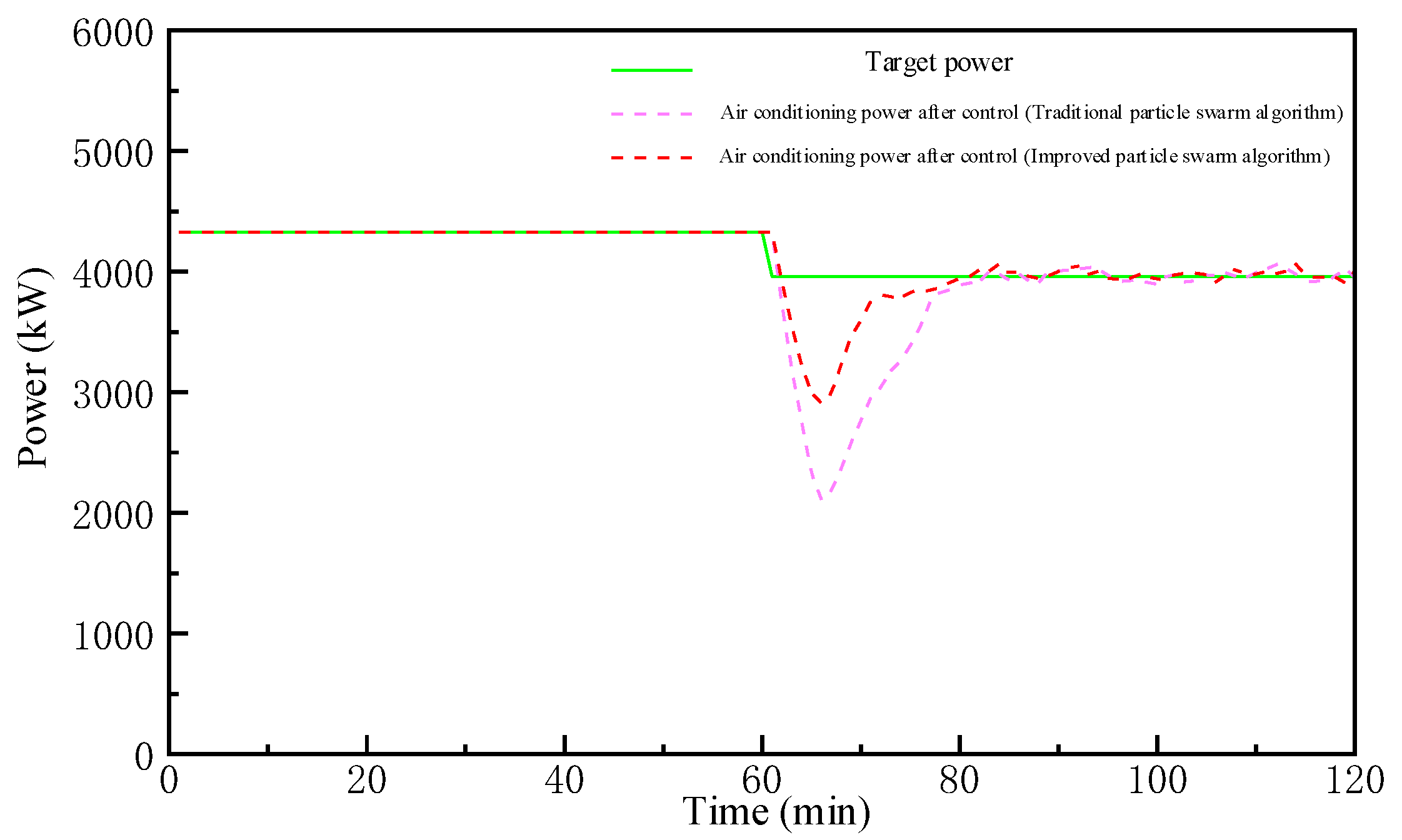
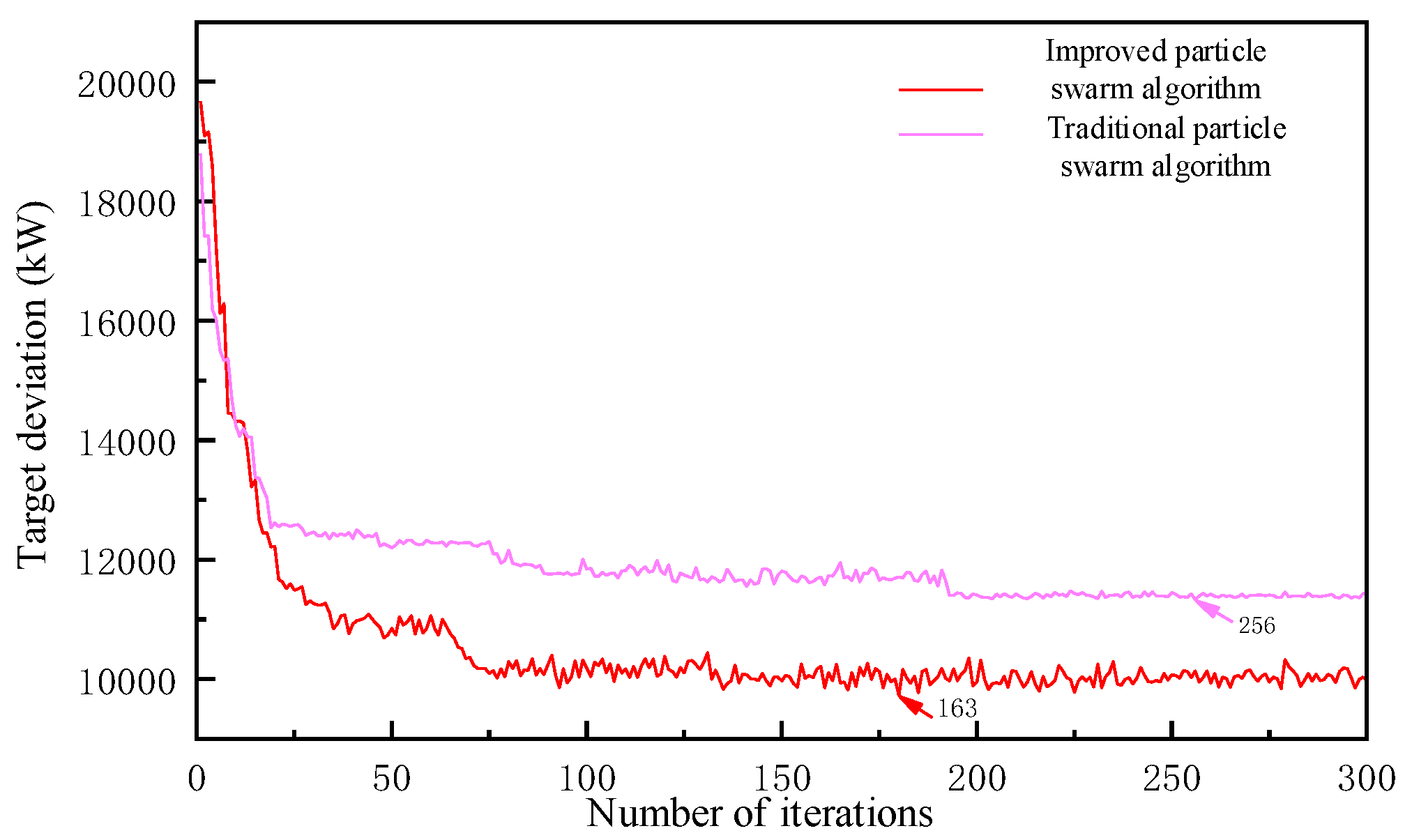
| Group | 1 | 2 | 3 | 4 | 5 | 6 | 7 | 8 | 9 | 10 | Total |
|---|---|---|---|---|---|---|---|---|---|---|---|
| Initial | 1 | 2 | 3 | 4 | 5 | 6 | 7 | 8 | 9 | 10 | 3 |
| 1 | 2 | 3 | 4 | 5 | 6 | 7 | 8 | 9 | 10 | 1 | 3 |
| 2 | 3 | 4 | 5 | 6 | 7 | 8 | 9 | 10 | 1 | 2 | 3 |
| 3 | 4 | 5 | 6 | 7 | 8 | 9 | 10 | 1 | 2 | 3 | 3 |
| 4 | 5 | 6 | 7 | 8 | 9 | 10 | 1 | 2 | 3 | 4 | 3 |
| 5 | 6 | 7 | 8 | 9 | 10 | 1 | 2 | 3 | 4 | 5 | 3 |
| 6 | 7 | 8 | 9 | 10 | 1 | 2 | 3 | 4 | 5 | 6 | 3 |
| 7 | 8 | 9 | 10 | 1 | 2 | 3 | 4 | 5 | 6 | 7 | 3 |
| 8 | 9 | 10 | 1 | 2 | 3 | 4 | 5 | 6 | 7 | 8 | 3 |
| 9 | 10 | 1 | 2 | 3 | 4 | 5 | 6 | 7 | 8 | 9 | 3 |
| 10 | 1 | 2 | 3 | 4 | 5 | 6 | 7 | 8 | 9 | 10 | 3 |
| 11 | 2 | 3 | 4 | 5 | 6 | 7 | 8 | 9 | 10 | 1 | 3 |
| 12 | 3 | 4 | 5 | 1 | 7 | 8 | 9 | 10 | 1 | 2 | 3 |
| Parameters | Range | Parameters | Range |
|---|---|---|---|
| R | [4.76, 6.36] | [24, 26] | |
| C | [0.13, 0.23] | δ | [1] |
| P | [2, 3] | η | [2.6, 2.8] |
| Exterior Temperature | |||||||||
|---|---|---|---|---|---|---|---|---|---|
| 26 | 27 | 28 | 29 | 30 | 31 | 32 | 33 | 34 | 35 |
| 0.29 | 0.34 | 0.40 | 0.45 | 0.60 | 0.66 | 0.69 | 0.78 | 0.78 | 0.83 |
| 0.22 | 0.29 | 0.34 | 0.40 | 0.45 | 0.60 | 0.66 | 0.69 | 0.78 | 0.78 |
| 0.14 | 0.22 | 0.29 | 0.34 | 0.40 | 0.45 | 0.60 | 0.66 | 0.69 | 0.78 |
| 0.00 | 0.14 | 0.22 | 0.29 | 0.34 | 0.40 | 0.45 | 0.60 | 0.66 | 0.69 |
| 0.00 | 0.00 | 0.14 | 0.22 | 0.29 | 0.34 | 0.40 | 0.45 | 0.60 | 0.66 |
| 0.00 | 0.00 | 0.00 | 0.14 | 0.22 | 0.29 | 0.34 | 0.40 | 0.45 | 0.60 |
| 0.00 | 0.00 | 0.00 | 0.00 | 0.14 | 0.22 | 0.29 | 0.34 | 0.40 | 0.45 |
Publisher’s Note: MDPI stays neutral with regard to jurisdictional claims in published maps and institutional affiliations. |
© 2022 by the authors. Licensee MDPI, Basel, Switzerland. This article is an open access article distributed under the terms and conditions of the Creative Commons Attribution (CC BY) license (https://creativecommons.org/licenses/by/4.0/).
Share and Cite
Liu, Q.; Fu, G.; Ma, G.; He, J.; Li, W. Research on Packet Control Strategy of Constant-Frequency Air-Conditioning Demand Response Based on Improved Particle Swarm Optimization Algorithm. Energies 2022, 15, 8985. https://doi.org/10.3390/en15238985
Liu Q, Fu G, Ma G, He J, Li W. Research on Packet Control Strategy of Constant-Frequency Air-Conditioning Demand Response Based on Improved Particle Swarm Optimization Algorithm. Energies. 2022; 15(23):8985. https://doi.org/10.3390/en15238985
Chicago/Turabian StyleLiu, Qian, Guangnu Fu, Gang Ma, Jun He, and Weikang Li. 2022. "Research on Packet Control Strategy of Constant-Frequency Air-Conditioning Demand Response Based on Improved Particle Swarm Optimization Algorithm" Energies 15, no. 23: 8985. https://doi.org/10.3390/en15238985
APA StyleLiu, Q., Fu, G., Ma, G., He, J., & Li, W. (2022). Research on Packet Control Strategy of Constant-Frequency Air-Conditioning Demand Response Based on Improved Particle Swarm Optimization Algorithm. Energies, 15(23), 8985. https://doi.org/10.3390/en15238985





